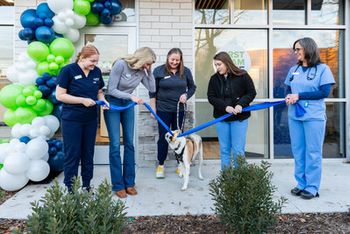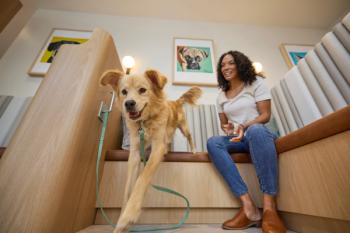
Persistence pays off
After 25 years of traveling to Garberville, Calif., to visit her family members, Dr. Judy Horvath and her husband, Steve Horvath, decided to simplify their lives and settle in the northern California village. Back in 1991, just two years after Dr. Horvath graduated from the University of California-Davis, the couple bought the only veterinary practice in the 1,200-person town.
By Carolyn Chapman
After 25 years of traveling to Garberville, Calif., to visit her family members, Dr. Judy Horvath and her husband, Steve Horvath, decided to simplify their lives and settle in the northern California village. Back in 1991, just two years after Dr. Horvath graduated from the University of California-Davis, the couple bought the only veterinary practice in the 1,200-person town.
Housed in a dark converted garage with old chain-link runs, the run-down veterinary practice needed major renovations. "It was no fun to work there," says Dr. Horvath. "The hospital was barely adequate." She quickly decided to start over in a new facility, but it was six long years before Dr. Horvath and her husband, the business manager, moved Garberville-Redway Veterinary Group into a new 3,990-square-foot freestanding building on the lip of a beautiful canyon.
Judges of Veterinary Economics' 2000 Hospital Design Competition raved about the hospital's vaulted reception area and the lab/pharmacy combination. "This is a clean, efficient design in a small space," applauded one competition judge. "The traffic flow is faultless."
Cantankerous county
When the Horvaths found the one-acre site just a half mile away from their old facility, a county official assured them that the land was zoned for development. But after signing the papers, the couple learned that the land, which sat on the edge of a steep wooded canyon, was designated green gulch overlay and couldn't be developed. Steve Horvath spent 18 months convincing county officials 65 miles away to change the land use designation to agricultural general so that the building project could proceed.
To assess earthquake and flood risk on the canyon rim and figure building setbacks, the couple ordered a geological survey. Boarding dictated the shape of the building because the Horvaths wanted indoor/outdoor runs, which they had to place away from a nearby fire station.
Next, the Horvaths showed architect Bill Betz of Eureka, Calif., a rough sketch of their ideas. "We decided to start locally and see what happened," Dr. Horvath says. They were pleased with the results. Betz's experience designing practices for dentists and optometrists helped him understand the needs of a veterinary clinic. "Bill really listened to what we wanted and worked with us," she says.
All bids barred
Personality--not price--led the Horvaths to contractor Ray Wolfe. Instead of accepting bids, the couple met with several contractors to review their plans and set a budget. Wolfe agreed to reduce his markup from 15 percent to 12 percent. "We didn't want an adversarial relationship with our contractor," says Steve Horvath. "And we didn't want to choose the lowest bid and get stuck with high-cost change orders. Instead, we met as friends and worked together." The hospital came in $7,000 under budget.
Daily walk-throughs also saved time and money. Steve Horvath caught such mistakes as not extending the walls to the roof, hanging the exam room doors with the window toward the reception area instead of the treatment area, and not sealing the seams on the floor.
The couple's insistence on a unique design and attention to the project details are paying off. Dr. Horvath says she particularly appreciates the new hospital's bright, open feel. "The old exam rooms felt like tiny closets," she recalls. "The new ones are twice as big, and using windows and high ceilings throughout gives the hospital a spacious and comforting atmosphere."
As you move through the practice, isolation sits conveniently between the day wards, an exam room, and the pharmacy. A four-zone ventilation system minimizes odor. "In the old clinic we had one ventilation system, and its intake duct was in the treatment area, so odors filled the hospital regularly," she says. "That practice never felt clean."
With little veterinary support in their remote location, the Horvaths take most of their own emergencies and rely on their own lab for test results. And they say the new facility's expanded lab and separate ICU ward mean better care for patients. Dr. Horvath says her varied clientele travels from as much as 40 miles away and expects a wide range of services, including grooming, boarding, and retail. "We treat pets whose owners refuse a rabies vaccination as well as pets whose owners demand topnotch care," she says. "The nearest specialty practice is three hours away, so we need to be ready to treat just about anything that walks in our door."
The Horvaths say attending a design conference and focusing on creating a plan that works for the way they practice contributed most to their design success. And someday, they say they may grow again.
"At one point, I dreamed of hiring a mixed animal associate to do farm calls," says Dr. Horvath. "Now when clients ask about it, I just tell them to be patient. We're growing, and we're committed to this town. You never know what we'll do next."
Carolyn Chapman, a former Veterinary Economics associate editor, is a freelance writer in Liberty, Mo.
February 2001 Veterinary Economics
Newsletter
From exam room tips to practice management insights, get trusted veterinary news delivered straight to your inbox—subscribe to dvm360.




